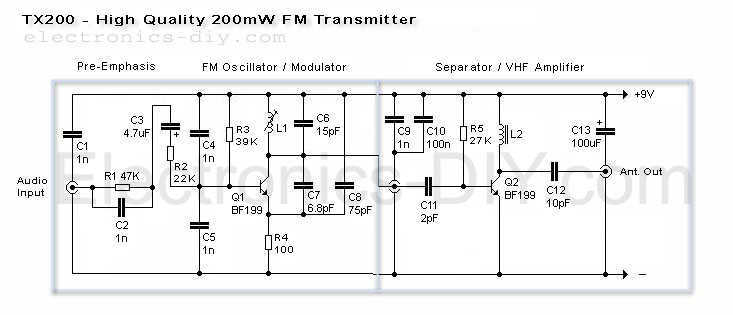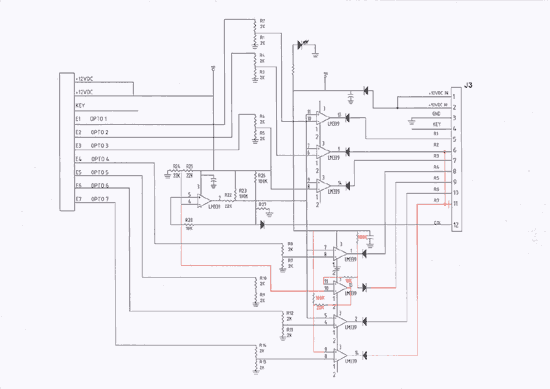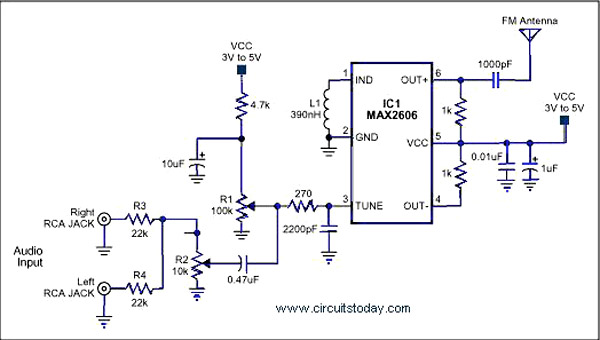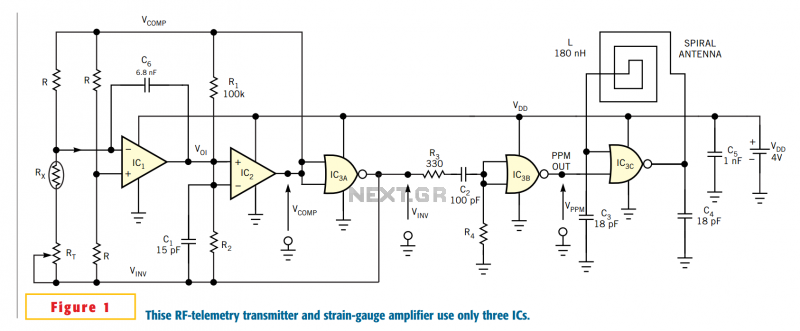
2 Watt FM Transmitter
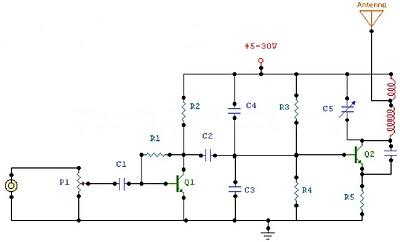
The circuit is a radio frequency (RF) oscillator that operates around 100 MHz. Audio signals captured and amplified by the electret microphone are sent to an audio amplifier stage constructed around the first transistor. The output from the collector of this transistor is directed to the base of a second transistor, where it modulates the resonant frequency of the tank circuit (composed of an L1 coil and a trim capacitor) by altering the junction capacitance of the transistor. The junction capacitance varies based on the potential difference applied to the base of the second transistor (T2). This tank circuit is configured within a Hartley oscillator circuit.
The described circuit functions as a radio frequency oscillator, specifically designed to operate at approximately 100 MHz. The initial stage involves an electret microphone, which serves to capture audio signals from the environment. The microphone's output is a weak analog signal, which is then amplified using a transistor-based audio amplifier. This amplification is crucial for ensuring that the subsequent stages of the circuit can effectively process the audio input.
The first transistor in the audio amplifier stage is responsible for boosting the audio signal's amplitude. The output from the collector of this transistor is crucial, as it serves as the input to the base of the second transistor (T2). The second transistor plays a pivotal role in modulating the RF signal. By applying the amplified audio signal to the base, the resonant frequency of the tank circuit is influenced.
The tank circuit itself comprises an inductor (L1 coil) and a variable capacitor (trim capacitor). This configuration is typical of a Hartley oscillator, which is known for its ability to generate stable oscillations at a specific frequency. The modulation of the resonant frequency occurs through the adjustment of the junction capacitance of the transistor T2. This capacitance is not a fixed value; rather, it is influenced by the voltage at the base of T2. As the audio signal varies, it alters the potential difference across the base-emitter junction, thereby changing the junction capacitance. This dynamic adjustment allows the circuit to effectively superimpose the audio signal onto the RF carrier wave generated by the tank circuit.
In summary, this circuit exemplifies a fundamental approach to RF signal modulation, utilizing a combination of audio amplification and frequency modulation techniques within a Hartley oscillator framework. The integration of the electret microphone, transistor amplifiers, and tank circuit components illustrates a practical application of electronic principles in RF communication systems.The circuit is basically a radio frequency (RF) oscillator that operates around 100 MHz. Audio picked up and amplified by the electret microphone is fed into the audio amplifier stage built around the first transistor. Output from the collector is fed into the base of the second transistor where it modulates the resonant frequency of the tank circ
uit (L1 coil and the trimcap) by varying the junction capacitance of the transistor. Junction capacitance is a function of the potential difference applied to the base of the transistor T2. The tank circuit is connected in a Hartley oscillator circuit. 🔗 External reference
The described circuit functions as a radio frequency oscillator, specifically designed to operate at approximately 100 MHz. The initial stage involves an electret microphone, which serves to capture audio signals from the environment. The microphone's output is a weak analog signal, which is then amplified using a transistor-based audio amplifier. This amplification is crucial for ensuring that the subsequent stages of the circuit can effectively process the audio input.
The first transistor in the audio amplifier stage is responsible for boosting the audio signal's amplitude. The output from the collector of this transistor is crucial, as it serves as the input to the base of the second transistor (T2). The second transistor plays a pivotal role in modulating the RF signal. By applying the amplified audio signal to the base, the resonant frequency of the tank circuit is influenced.
The tank circuit itself comprises an inductor (L1 coil) and a variable capacitor (trim capacitor). This configuration is typical of a Hartley oscillator, which is known for its ability to generate stable oscillations at a specific frequency. The modulation of the resonant frequency occurs through the adjustment of the junction capacitance of the transistor T2. This capacitance is not a fixed value; rather, it is influenced by the voltage at the base of T2. As the audio signal varies, it alters the potential difference across the base-emitter junction, thereby changing the junction capacitance. This dynamic adjustment allows the circuit to effectively superimpose the audio signal onto the RF carrier wave generated by the tank circuit.
In summary, this circuit exemplifies a fundamental approach to RF signal modulation, utilizing a combination of audio amplification and frequency modulation techniques within a Hartley oscillator framework. The integration of the electret microphone, transistor amplifiers, and tank circuit components illustrates a practical application of electronic principles in RF communication systems.The circuit is basically a radio frequency (RF) oscillator that operates around 100 MHz. Audio picked up and amplified by the electret microphone is fed into the audio amplifier stage built around the first transistor. Output from the collector is fed into the base of the second transistor where it modulates the resonant frequency of the tank circ
uit (L1 coil and the trimcap) by varying the junction capacitance of the transistor. Junction capacitance is a function of the potential difference applied to the base of the transistor T2. The tank circuit is connected in a Hartley oscillator circuit. 🔗 External reference
